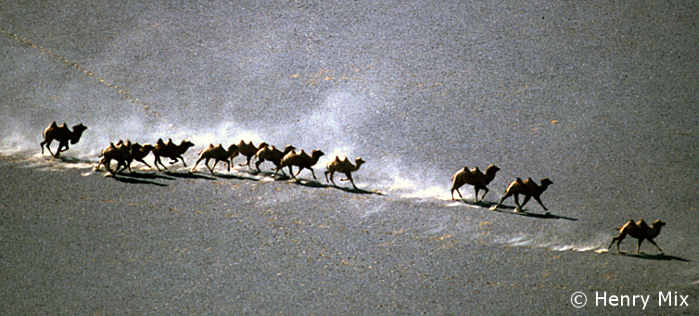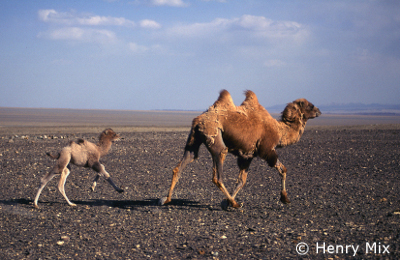The only true wild camels that still exist are Bactrian camels (Camelus ferus). This species can survive in one of the most hostile environments on Earth, the Gobi desert of Mongolia, withstanding long periods of drought, starvation and even radiation from nuclear weapons testing.

The ancestors of the true camels migrated to Asia about 3-4 million years ago, giving rise to the modern wild Bactrian camel. This is one of two surviving camel species that are generally recognised: the other being the dromedary or one-humped camel. The Bactrian camel is likely to have been domesticated sometime before 2500 BC, either in Iran or adjacent countries in the Middle East. There is some evidence to suggest the domestic and wild Bactrian camels are different subspecies because of significant genetic variation between them and the fact that they have had difficulty interbreeding.
The two-humped wild Bactrian camel is smaller than its domestic relative, and has a number of adaptations to help it survive, such as a double row of long eyelashes and the ability to close their narrow nostrils for protection during sandstorms. The foot has a tough sole with two toes that spread for easy travel across shifting terrain and rocky outcrops. The Bactrian camel has a thick, shaggy coat during the harsh winters and sheds this rapidly in the spring. An unusual feature that distinguishes the Camelid family from all other mammals is their oval shaped (instead of circular) red blood cells, which circulate even in thick blood caused by severe dehydration. The oval shape is also more stable, which prevents the cells rupturing if the camels drink large amounts of water in one sitting.
Wild Bactrian camels sleep at night and forage for food during the day. They feed on thorns, dry vegetation and salty plants, which other herbivores avoid. Excess fat is stored in the humps and used as a nutrient reserve, which allows the camels to go for several days without eating or drinking. Bactrian camels can migrate vast distances, and upon finding water they will rapidly drink vast quantities: they can take in as much as 57 litres at once. In winter, they are often limited to eating snow for hydration. If no fresh water is available, unlike other mammals Bactrian camels can drink salty water with no ill effects.
The camels’ distribution is linked to the availability of water, with large groups congregating near rivers or at mountain bases. Fewer than 1,000 wild Bactrian camels survive today in only three locations in northwest China and one in the Gobi desert of southwest Mongolia. Classified as Critically Endangered in 2010 by the IUCN, these animals continue to be threatened by habitat loss from mining and industry, and competition with introduced livestock, which increases hunting by farmers as well. The Mongolian population has almost halved in the last twenty years.

The governments of China and Mongolia agreed to cooperate in order to protect the species, and two reserves have been created which provide a safe habitat for endangered desert animals and plants, as well as the wild Bactrian camels. Two EDGE Fellows have set up conservation projects for the Bactrian camel in both Mongolia and China since 2007, and the Wild Camel Protection Foundation set up a breeding programme in 2003 to try and recover species numbers.
Why not have a browse through more EDGE species or read more about our work with the Bactrian camel?
